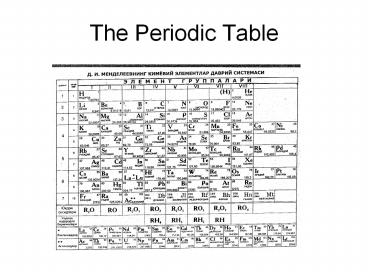The Periodic Table PowerPoint PPT Presentation
Title: The Periodic Table
1
The Periodic Table
2
Periodic Table
Dmitri Mendeleev (1834-1907)
"We could live at the present day without a
Plato, but a double number of Newtons is required
to discover the secrets of nature, and to bring
life into harmony with the laws of nature."
3
Modern Periodic Table
4
s- and p-orbitals
Aufbau Principle filling orbitals
H 1s1
5
s- and p-orbitals
Aufbau Principle filling orbitals
He 1s2
6
s- and p-orbitals
Aufbau Principle filling orbitals
Li 1s2 2s1
7
s- and p-orbitals
Aufbau Principle filling orbitals
Be 1s2 2s2
8
s- and p-orbitals
Aufbau Principle filling orbitals
9
s- and p-orbitals
Aufbau Principle filling orbitals
Hunds rule maximum number of unpaired electrons
is the lowest energy arrangement.
10
s- and p-orbitals
Aufbau Principle filling orbitals
11
s- and p-orbitals
Aufbau Principle filling orbitals
12
s- and p-orbitals
Aufbau Principle filling orbitals
Na 1s22s22p63s1
or Ne3s1
P Ne3s23p3
Ar Ne3s23p6
Mg 1s22s22p63s2
or Ne3s2
13
d-orbitals
3d
4s
3p
3s
2p
E
2s
1s
Due to deeper penetration of s-orbitals, 4s lies
lower in energy than 3d
14
d-orbitals
K 1s22s22p63s23p64s1
or Ar4s1
Co Ar4s23d7
Ca Ar4s2
Cu Ar4s13d10
Sc Ar4s23d1
Zn Ar4s23d10
V Ar4s23d3
Ga Ar4s23d104p1
Cr Ar4s13d5
Kr Ar4s23d104p6
15
Beyond the d-orbitals
d-transition elements
lanthanides
actinides
f-transition elements
16
Aufbau rules
1. Within a shell (n) the filling order is sgtpgtdgtf
2. Within a subshell (l), lowest energy
arrangement has the highest number of unpaired
spin (Hunds rule)
3. The (n1)s orbitals always fill before the nd
orbitals
4. After lanthanum (Xe6s25d1), the 4f orbitals
are filled
5. After actinium (Rn7s26d1), the 5f orbitals
are filled
Filled subshells accommodate
s 2 electrons
d 10 electrons
p 6 electrons
f 14 electrons
17
Electron configuration
Give the electron configuration of Zirconium and
Tellurium.
Identify the period and the group of the element
Zirconium is in period 5 and is the 2nd element
in the d-transition element group.
Zr 1s22s22p63s23p64s23d104p65s24d2
or Kr5s24d2
Tellurium is in period 5 and is the 4th element
in the p- group.
Te 1s22s22p63s23p64s23d104p65s24d105p4
or Kr5s24d105p4
18
Exotic elements
Elements with atomic numbers higher than 92
(Uranium) typically dont exist in nature and
have to be made by nuclear synthesis
The first synthesized elements were named after
the planets
19
Exotic elements
Lives for only 10 ms!
No name yet!
20
Atomic Radius
How big is an atom?
The atomic radius r is usually determined from
the distances between atoms in covalent bonds.
Atomic radius decreases across a period from left
to right due to increased effective nuclear
charge
Atomic radius increases down a group because of
the larger sizes of the orbitals with higher
quantum numbers.
21
Atomic Radius
22
Atomic Radius
23
Atomic Radius
Covalent radius is much smaller than the anionic
radius.
24
Atomic Radius
Arrange the following sets of atoms in order of
increasing size
Sr, Se, Ne
Ne(10) lt Se(34) lt Sr(38)
Fe, P, O
O(8) lt P(15) lt Fe(26)
Li(3) lt Na(11) lt Rb(37)
F-(9) lt Cl-(17) lt I-(53)
25
Ionization Energy
Ionization energy is the energy required to
remove an electron from a gaseous atom or ion
26
Ionization Energy
S 1s22s22p63s23p4
Which electrons are removed in successive
ionizations?
Electrons in the outer subshells take the least
amount of energy to remove (valence electrons)
It takes about 1103 kJ/mol to remove successive
electrons from the 3p shell of sulfur.
27
Ionization Energy
Ionization energies of aluminum
Al 1s22s22p63s23p1
1st electron 3p valence electron
2nd electron 3s valence electron
3rd electron 3s valence electron
core electrons take much more energy to remove
4th electron 2p core electron!
28
Ionization Energy
29
Ionization Energy
First ionization energies
General trends
Ionization energy increases across the period
from left to right.
Ionization energy decreases going down a group
30
Ionization Energy
A closer look..
B 1s22s22p1
New subshell, electron is easier to remove.
O 1s22s22p4
First paired electron in 2p orbital repulsion.
31
Understanding a group
Atoms in a group have the same valence electron
configuration and share many similarities in
their chemistry.
Group 1A Alkali metals
32
Understanding a group
Group 1A Alkali metals
Trends down the group reflect periodic changes in
mass, volume and charge.
33
Periodic Table in Brief
34
Periodic Table Redux
35
Periodic Table Redux

